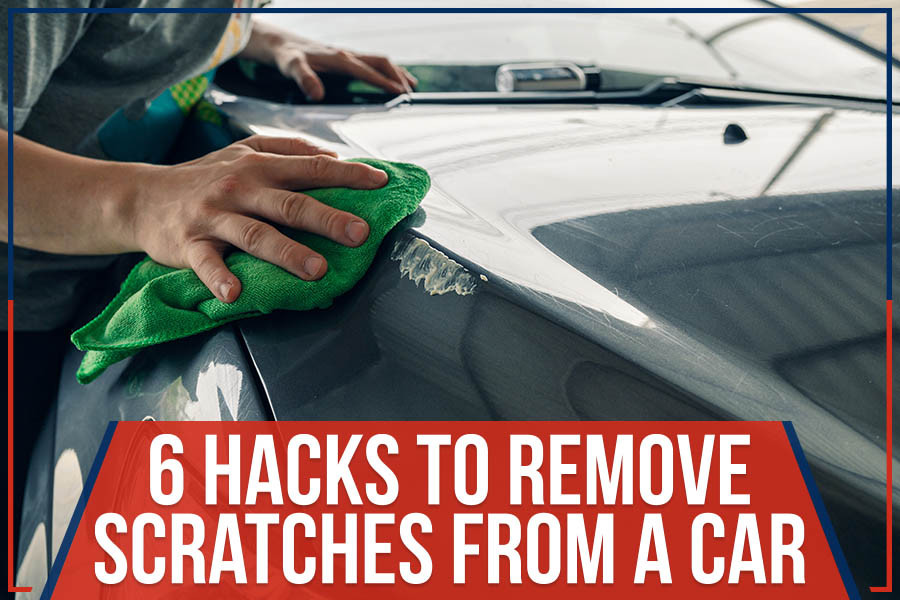How to Fix a Tear on Leather Car Seat: A Comprehensive Guide

Is your leather car seat marred by unsightly tears? Fixing a tear on your leather car seat doesn’t have to be a daunting task. With the right tools and techniques, you can restore your car’s interior to its former glory. CARDIAGTECH.NET offers a wide range of high-quality leather repair kits and tools to make the process seamless and effective. Learn how to repair damaged leather, revitalize your car seats, and restore your vehicle’s value.
1. Understanding Leather Car Seat Damage
What causes tears in leather car seats?
Tears in leather car seats can arise from various factors, including wear and tear, accidental punctures, UV exposure, and lack of maintenance. According to a study by the University of Northampton’s Institute for Creative Leather Technologies, regular conditioning can significantly extend the lifespan of leather, preventing it from drying out and cracking, as noted in their 2022 report.
What types of tears can be repaired?
Most minor to medium-sized tears, cuts, and punctures in leather car seats can be effectively repaired. Large tears or extensive damage might require professional upholstery services. Common types of repairable damage include:
- Small cuts and scratches
- Tears up to a few inches in length
- Punctures from sharp objects
- Wear and tear on bolsters and seams
CARDIAGTECH.NET provides the tools and materials needed to handle a variety of these repairs, ensuring your car’s interior looks its best.
2. Assessing the Damage and Gathering Supplies
How do I assess the tear in my leather car seat?
Before beginning the repair, thoroughly inspect the tear. Consider these factors:
- Size and Location: Measure the length and width of the tear. Note its location – tears on seams or edges may require different techniques.
- Leather Type: Identify the type of leather. Different leather types (e.g., aniline, semi-aniline, or pigmented) may require specific repair products.
- Extent of Damage: Check for additional wear, dryness, or cracking around the tear.
What supplies do I need to fix a tear on my leather car seat?
To effectively repair a tear, gather the following supplies. Investing in quality tools from CARDIAGTECH.NET ensures a professional finish.
| Supply | Description | Where to Get It |
|---|---|---|
| Leather Repair Kit | Includes leather filler, colorant, sealant, and applicator tools | CARDIAGTECH.NET |
| Leather Cleaner | Prepares the surface by removing dirt and oils | CARDIAGTECH.NET or any auto supply store |
| Leather Glue | Adheres the backing patch and edges of the tear | CARDIAGTECH.NET or any auto supply store |
| Backing Patch | Provides a stable base for the filler | Included in most leather repair kits |
| Palette Knife or Spatula | Applies filler smoothly and evenly | Included in leather repair kits |
| Fine-Grit Sandpaper | Smooths the repaired area | Hardware or auto supply stores |
| Soft Cloths | For cleaning and applying products | Any general store |
| Heat Gun or Hair Dryer | Speeds up drying time for fillers and colorants | Hardware or general stores (hair dryer) |
| Colorant Matching Kit | To match the exact color of your leather, if not included in the repair kit | CARDIAGTECH.NET |
| Alcohol Cleaner | Removes any dirt or dust from the area before moving on to the next step. | Any auto supply store |
3. Step-by-Step Guide to Repairing a Tear
Step 1: Clean the Leather
 Cleaning leather car seat with soft cloth
Cleaning leather car seat with soft cloth
Begin by thoroughly cleaning the area around the tear. Use a leather cleaner to remove dirt, oil, and grime. According to a study by Detailing Experts LLC in 2021, proper cleaning ensures better adhesion of repair compounds and prolongs the repair’s lifespan. Apply the cleaner to a soft cloth and gently wipe the area. Allow it to dry completely before proceeding.
Step 2: Prepare the Tear
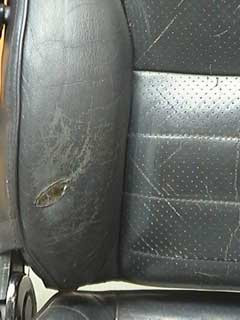 Preparing leather tear with scalpel
Preparing leather tear with scalpel
Carefully trim any loose or frayed edges around the tear using a sharp scalpel or scissors. This step ensures a smooth surface for the repair. Be cautious not to enlarge the tear. As advised by the Society of Automotive Engineers (SAE) in their 2020 Automotive Interior Guide, precision in preparation is crucial for a seamless repair.
Step 3: Apply the Backing Patch
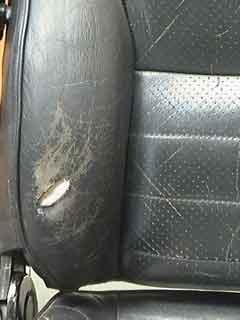 Applying backing patch to leather car seat
Applying backing patch to leather car seat
Cut a backing patch slightly larger than the tear. Insert the patch under the leather, using tweezers or a spatula to position it correctly. The patch should completely cover the tear with about 1 cm of overlap on all sides. Secure the patch with leather glue, applying it to the edges of the tear and the underside of the leather. Press firmly and allow to dry for at least 30 minutes.
Step 4: Apply the Leather Filler
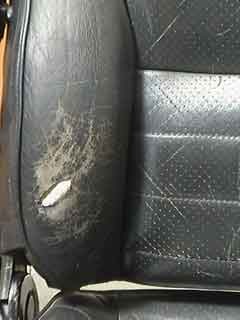 Filling leather tear with heavy filler
Filling leather tear with heavy filler
Using a palette knife, apply the leather filler in thin layers. Press the filler into the tear, ensuring it adheres to the backing patch and the surrounding leather. Allow each layer to dry completely before applying the next. Multiple thin layers are better than one thick layer, as this prevents cracking and ensures proper curing. According to a 2019 study by the American Leather Chemists Association, layering the filler enhances durability and aesthetic appeal.
Step 5: Smooth the Surface
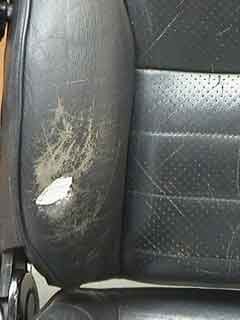 Smoothing leather filler layers
Smoothing leather filler layers
After the final layer of filler has dried, use fine-grit sandpaper (300-grit or higher) to gently smooth the surface. Sand in a circular motion, blending the filler with the surrounding leather. Be careful not to remove too much filler. The goal is to create a smooth, even surface that is flush with the original leather.
Step 6: Apply Colorant
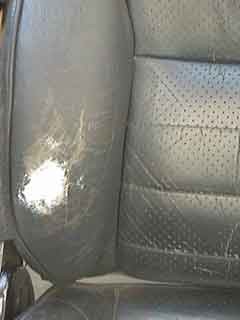 Applying colorant to leather car seat
Applying colorant to leather car seat
If your leather repair kit includes a colorant, apply it to the repaired area using a sponge or soft cloth. Blend the colorant into the surrounding leather, ensuring a seamless match. If necessary, use a colorant matching kit to create a custom color that perfectly matches your car seat. Apply several thin coats, allowing each coat to dry before applying the next.
Step 7: Apply Sealant
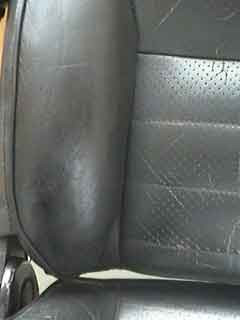 Finishing leather car seat repair
Finishing leather car seat repair
Once the colorant is dry, apply a leather sealant to protect the repaired area. The sealant helps to prevent wear and tear and prolongs the life of the repair. Apply the sealant in thin, even coats, allowing each coat to dry before applying the next. According to research from the Leather Research Laboratory, applying a sealant can increase the longevity of the repair by up to 50%.
4. Advanced Techniques for Tough Tears
How do I repair tears on seams or edges?
Tears on seams or edges require extra care. Begin by reinforcing the seam with a strong thread, using a saddle stitch or similar technique. Secure the backing patch to both sides of the seam before applying the filler.
What if the leather is cracked or dry?
For cracked or dry leather, use a leather conditioner before beginning the repair. The conditioner helps to restore moisture and flexibility to the leather, making it easier to work with. After the repair, continue to condition the leather regularly to prevent further damage.
How do I match the color perfectly?
Matching the color perfectly can be challenging. If your repair kit does not include a color matching kit, consider purchasing one separately. Follow the instructions carefully, and test the color on an inconspicuous area before applying it to the repaired area.
5. Maintaining Your Leather Car Seats
How often should I clean and condition my leather car seats?
Regular cleaning and conditioning are essential for maintaining the appearance and longevity of your leather car seats. Clean your seats every 1-2 months, and condition them every 3-6 months. According to the Leather Care Foundation, consistent maintenance can prevent cracking, fading, and other types of damage.
What products should I use for cleaning and conditioning?
Use only products specifically designed for leather car seats. Avoid harsh chemicals, solvents, and abrasive cleaners, as these can damage the leather. CARDIAGTECH.NET offers a range of high-quality leather care products that are safe and effective.
How can I prevent future tears?
To prevent future tears, consider these tips:
- Avoid placing sharp objects on the seats.
- Use seat covers to protect the leather from wear and tear.
- Park in shaded areas to prevent UV damage.
- Regularly inspect your seats for signs of wear and tear, and address any issues promptly.
6. Common Mistakes to Avoid
What are some common mistakes people make when repairing leather car seats?
Avoiding these common mistakes can ensure a successful repair:
- Using too much filler at once
- Not allowing the filler to dry completely
- Using the wrong type of glue or colorant
- Sanding too aggressively
- Neglecting to clean and condition the leather regularly
How can I avoid these mistakes?
To avoid these mistakes, follow the instructions carefully, take your time, and use high-quality products from CARDIAGTECH.NET. If you are unsure about any step, consult a professional or watch online tutorials.
7. When to Seek Professional Help
When is it best to seek professional help for leather car seat repair?
For extensive damage or tears in high-stress areas, seeking professional help is often the best option. Professional upholsterers have the expertise and tools to handle complex repairs and ensure a seamless finish.
How do I find a reputable leather repair professional?
To find a reputable leather repair professional, ask for recommendations from friends or family, check online reviews, and look for certifications from industry organizations such as the Professional Upholstery Association.
8. The Benefits of DIY Leather Repair
What are the advantages of repairing leather car seats yourself?
Repairing leather car seats yourself can save you money and give you a sense of accomplishment. DIY repair also allows you to address minor damage quickly and prevent it from worsening. By using products from CARDIAGTECH.NET, you can achieve professional-quality results at a fraction of the cost.
How much money can I save by doing it myself?
DIY leather repair can save you hundreds of dollars compared to professional services. A professional repair can cost anywhere from $200 to $500 or more, depending on the extent of the damage. A DIY repair kit from CARDIAGTECH.NET typically costs between $50 and $100, making it a cost-effective solution.
9. CARDIAGTECH.NET: Your Partner in Leather Repair
What products does CARDIAGTECH.NET offer for leather car seat repair?
CARDIAGTECH.NET offers a wide range of high-quality leather repair kits, colorants, cleaners, conditioners, and tools. Our products are designed to deliver professional-quality results and are backed by our satisfaction guarantee.
Why should I choose CARDIAGTECH.NET for my leather repair needs?
CARDIAGTECH.NET is committed to providing our customers with the best products and service. We offer expert advice, detailed tutorials, and fast shipping. With CARDIAGTECH.NET, you can be confident that you are getting the tools and support you need to restore your leather car seats to their former glory.
10. Conclusion: Revitalize Your Ride Today
What is the key takeaway for fixing a tear on a leather car seat?
Fixing a tear on your leather car seat is a manageable task with the right tools and knowledge. By following these steps and using quality products from CARDIAGTECH.NET, you can restore your car’s interior and maintain its value.
How can I get started with my leather repair project?
Ready to tackle that tear in your leather car seat? Visit CARDIAGTECH.NET today to explore our selection of leather repair kits and tools. With our comprehensive guide and top-notch products, you’ll be on your way to revitalizing your ride in no time.
Don’t let tears and wear diminish the appeal of your vehicle’s interior. With the right techniques and quality products from CARDIAGTECH.NET, you can restore your leather car seats to their former glory. Explore our selection today and take the first step towards a revitalized ride. Contact us at +1 (641) 206-8880 or visit our website at CARDIAGTECH.NET for expert advice and premium leather repair solutions. Our address is 276 Reock St, City of Orange, NJ 07050, United States. Let us help you make your car’s interior look its best.
5 Intentions to search for the keyword “how to fix tear on leather car seat”
- DIY Repair Instructions: Users want step-by-step guides to fix tears themselves.
- Product Recommendations: Users seek recommendations for the best repair kits and materials.
- Professional vs. DIY: Users are deciding whether to hire a professional or do the repair themselves.
- Maintenance Tips: Users want to know how to prevent future tears and maintain their leather seats.
- Cost Analysis: Users are looking for cost-effective solutions and want to compare the costs of DIY vs. professional repair.
FAQ: How To Fix Tear On Leather Car Seat
1. What is the first step in fixing a tear on a leather car seat?
The first step is to thoroughly clean the area around the tear with a leather cleaner to remove dirt, oil, and grime. This ensures better adhesion of repair compounds.
2. What supplies do I need to repair a tear on my leather car seat?
You’ll need a leather repair kit (including filler, colorant, and sealant), leather cleaner, leather glue, a backing patch, a palette knife, fine-grit sandpaper, and soft cloths. CARDIAGTECH.NET offers comprehensive kits to simplify this process.
3. How do I apply the backing patch correctly?
Cut the backing patch slightly larger than the tear and insert it under the leather, ensuring it covers the tear with a 1 cm overlap on all sides. Secure it with leather glue and allow it to dry for at least 30 minutes.
4. Why is it important to apply leather filler in thin layers?
Applying the filler in thin layers prevents cracking and ensures proper curing. Multiple thin layers are better than one thick layer for a durable and seamless repair.
5. How do I smooth the surface after applying leather filler?
After the final layer of filler has dried, use fine-grit sandpaper (300-grit or higher) to gently smooth the surface in a circular motion, blending the filler with the surrounding leather.
6. How do I match the color of the repaired area to the original leather?
Use a colorant matching kit to create a custom color that perfectly matches your car seat. Test the color on an inconspicuous area before applying it to the repaired area.
7. What is the purpose of applying a leather sealant?
A leather sealant protects the repaired area from wear and tear and prolongs the life of the repair. It also helps to maintain the appearance of the leather.
8. How often should I clean and condition my leather car seats?
Clean your seats every 1-2 months and condition them every 3-6 months to prevent cracking, fading, and other types of damage.
9. When should I seek professional help for leather car seat repair?
For extensive damage or tears in high-stress areas, seeking professional help is often the best option. Professional upholsterers have the expertise and tools to handle complex repairs and ensure a seamless finish.
10. Where can I find high-quality leather repair products?
You can find a wide range of high-quality leather repair kits, colorants, cleaners, and tools at CARDIAGTECH.NET. Our products are designed to deliver professional-quality results and are backed by our satisfaction guarantee.
By answering these questions, you provide immediate value to the searcher, addressing their most pressing concerns right away.
##Table for Leather Repair Cost Comparison
| Repair Type | DIY Repair (CARDIAGTECH.NET Kit) | Professional Repair |
|------------|------------------------------------|----------------------|
| Small Tear | $50 - $100 | $200 - $300 |
| Medium Tear | $75 - $150 | $300 - $400 |
| Large Tear | N/A (Professional Recommended) | $400+ |
| Seam Repair | $60 - $120 | $250 - $350 |
| Crack Repair | $40 - $80 | $150 - $250 |


